Native to Northwest America, the Douglas fir was introduced to Europe in 1827, mainly because of its growth potential and the high quality of its timber. This conifer has gone on to become one of Central Europe's most important non-native tree species, with the coast Douglas fir (P. menziesii var. menziesii) being the most common. This provenance is particularly suitable for Central European forests. Its high increment rates, ability to rapidly seal wounds and low number of associated diseases have contributed to its spread. All in all, this tree species is considered to be more productive, adaptable and resistant to damage than the spruce.
However, even the Douglas fir is not immune to diseases and pests. Up to the thicket stage, it is even one of the tree species in Europe most sensitive to disturbances. In particular, abiotic influences such as high humidity and waterlogging have a negative impact on these trees, while game, fungi and insects can also cause problems. By contrast, the Douglas fir is mostly invulnerable to pests and diseases in the timber and mature timber stage.
Game
Introduced tree species such as the Douglas fir are very attractive to game and are therefore particularly at risk. Douglas firs are most heavily damaged by thrashing. The males of the red deer (Cervus elaphus), roe deer (Capreolus capreolus) and sika deer (Cervus nippon) remove the velvet from their newly formed antlers by thrashing them against Douglas firs in the thicket stage, thus marking their territory and tearing the bark of the tree in the process.
Browsing of Douglas firs mainly occurs in winter. The tree's popularity and the resulting loss of increment are somewhat lower than those of the silver fir. However, repeated browsing of the top shoots also results in permanent loss of quality. This is particularly significant in the case of planted trees, as these are individual investments.
Red and sika deer also damage Douglas firs in the pole wood stage by stripping the bark off trees. The hazard is less serious than that faced by the spruce and the hazard period is also shorter because Douglas fir bark brittles earlier. The loss of quality is low because the Douglas fir is able to heal such wounds relatively well. Damage is significant from the young stand to pole wood stage, especially in trees between 8 and 25 years old.
The Douglas fir is a popular tree for wild boars (Sus scrofa) to rub against. Trees heavily used in this way tend to fall down. The phenomenon occurs mainly in the vicinity of bait sites. The Douglas fir is also of interest to smaller animals. The bank vole (Clethrionomys glareolus), for instance, feeds on buds and shoots from late summer onwards. However, the damage typically only becomes noticeable in late autumn, when the bark on branch whorls is gnawed in places and stands out in particular due to its light colour.
Protective measures against game include individual mechanical protection mechanisms, such as mesh tree guards or fencing. The usual means to prevent stripping (e.g. polynet or chemical protection using paint containing quartz sand) do not sufficiently protect Douglas firs. Moreover, such measures are ineffective against thrashing. To protect the trunk against such damage, a two-metre-high wire mesh fence can be erected at some distance around the tree and fastened to a pole.
Fungi
Fungi pose a major problem for Douglas firs when it comes to forest protection, especially needle cast fungi (such as Swiss needle cast and Rhabdocline needle cast).
Swiss needle cast (Nothophaeocryptopus gäumannii, syn. Phaeocryptopus gäumannii) mainly causes significant damage in dense stands where humidity is high, with the damage being considerably greater in years with wet early summers. Depending on the intensity of the infestation, needles are shed after one to three years and frost resistance is reduced. The combination of frost and fungal attack accelerates and exacerbates needle loss, resulting in substantial increment loss. However, even a severe infestation does not usually cause the tree to die. In contrast, secondary damage caused by the dark honey fungus (Armillaria ostoyae) or insects such as the six-toothed spruce bark beetle (Pityogenes chalcographus) or the fir bark beetle (Pityophthorus pityographus) will occur in the case of major needle cast infestations lasting several years. Trees can also be infested with the Cooley spruce gall adelgid (Gilletteella cooleyi) at the same time.
Rhabdocline needle cast (Rhabdocline pseudotsugae) often leads to the death of the tree. Compared with Swiss needle cast, Rhabdocline needle cast progresses much more quickly and intensively. However, our most common Douglas fir variety (Pseudotsuga menziesii var. menziesii) has proven to be highly resistant, whereas the varieties P. menziesii var. glauca and var. caesia are only suitable for cultivation in clearly continental climates due to their vulnerability to such infestations.
Dothistroma needle blight (Dothistroma sp.) can also affect Douglas firs. This fungal disease is mainly seen on pines and is considered a particularly dangerous organism. Very serious outbreaks of this disease can jump to Douglas firs from neighbouring pines.
Diseases affecting the shoots of the Douglas fir can be caused by Allantophomopsiella pseudotsugae (syn. Phacidium coniferarum, Phomopsis pseudotsugae), Botrytis cinerea or Sirococcus conigenus. A. pseudotsugae, which causes phomopsis disease in Douglas firs, is probably the most concerning. It attacks the bark of twigs and trunks, causing it to die. This interrupts the supply to the higher parts of the tree, causing the needles of the affected branches to turn red and the top to die.
The fungus occurs on the bark of various conifers, but only damages Douglas fir and occasionally the Japanese larch. Young Douglas firs weakened by frost, lack of water, plant shock, damage to bark, hail damage, severe needle cast or other stress factors are particularly at risk. The greatest outbreaks often occur in the first year after planting, when weakening due to lack of water and winter desiccation facilitates the spread of the fungus in the leaves.
Grey mould rot (Botrytis cinerea) is only harmful if there is high humidity and frost. Damage is usually limited to the needles and the as-yet immature primary shoots of individual trees. Sirococcus shoot blight is mainly found on spruces, but can also affect Douglas firs. The needles of young shoots die, the shoot tips become bare and bend like hooks.
The dark honey fungus (Armillaria ostoyae) is the most significant rot pathogen affecting Douglas firs. The tree species is particularly susceptible to this pathogen in combination with an infestation of Rhabdocline needle cast. When it comes to other root rots as well, Douglas fir is among the more susceptible species. Areas formerly planted with pines on sandy soils are predestined for infection with dyer's polypore (Phaeolus schweinitzii) and conifer root and butt rot (Heterobasidion annosum). The wood cauliflower (Sparassis crispa) causes stump rot on Douglas firs, though this is restricted to the base of the tree. The yellow stagshorn (Calocera viscosa) also causes trunk and root rots, but lives mostly as a saprobe on stumps.
Insects
While Douglas firs in North America are home to a large number of insect species, including several that could cause damage, the situation in Switzerland and Europe is still largely unproblematic. Aside from the American utilizable wood bark beetle (Gnathotrichus materiarius), which was first observed in Switzerland in 1984 and prefers to attack Scots pines, no other American bark beetles of the Douglas fir have been introduced to Europe so far. Various insect species of the Douglas fir appear in Switzerland mainly in combination with other influences such as needle fungi or winter frost damage.
The native insects that use the Douglas fir as a host tree include the large pine weevil, native green leaf weevil species, the pine processionary moth and the fir bark beetle.
The adults of the large pine weevil (Hylobius abietis) gnaw the bark of young trunks near the ground during maturation feeding. If the pockmarked feeding pattern covers the entire trunk, the young tree dies. Since the beetle larvae develop in the roots of fresh stumps, significant damage mainly occurs in large-scale plantings following clear cutting or storm damage.
Native green leaf weevil species (e.g. Phyllobius spp., Polydrusus spp.) sometimes feed on young Douglas fir needles. Feeding on the shoots causes damage similar to that of late frost due to the brown colouring of the youngest needle class and is sometimes conspicuous, but is usually minor. Noticeable increment loss mostly occurs in forest nurseries.
The pine processionary moth (Thaumetopoea pityocampa) can infest Douglas firs as well as pines. It is found on the southern side of the Alps as well as in Valais and the Lake Geneva area. From the pole wood stage onwards, the distinct, fist-sized hibernation nests of the caterpillars can then be observed in the tree crowns. However, feeding in the crowns is mostly insignificant and damage is usually negligible; to date, major feeding damage has only been observed on younger pines or in monocultures. The pine processionary moth could become a serious danger to the Douglas fir, however, should the caterpillars' preference for Douglas fir needles observed in the laboratory replicate itself in the field.
Bark beetles are also found on Douglas firs. The fir bark beetle (Pityophthorus pityographus) is by far the most common insect to nest in pre-weakened young Douglas firs, causing them to die. The star-shaped breeding gallery of this small bark beetle species is recognisable by the way the mating chambers clearly sink into the sapwood.
The fir bark beetle occasionally also appears with the six-toothed spruce bark beetle (Pityogenes chalcographus). Sometimes both species are seen on the same Douglas fir. Other native softwood bark beetles can also be found on Douglas fir from time to time, mainly in horizontal infestations. In Switzerland, the larger eight-toothed European spruce bark beetle (Ips typographus), the large larch bark beetle (Ips cembrae), the grained spruce bark beetle (Cryphalus abietis), the striped ambrosia beetle (Xyloterus lineatus) and the black timber bark beetle (Xylosandrus germanus), which has become naturalised from East Asia, have already been found on Douglas firs. In addition, several other native forest insects, mainly butterflies and beetles, have taken Douglas fir as their host tree in Europe. So far, however, there have been no reports of damage in Switzerland in this respect.
Some insect species migrated with their host tree in the 19th century and have become established here. The Douglas fir seed chalcid (Megastigmus spermotrophus) is one example. Unlike in America, however, the chalcid does not cause significant seed loss here. As in North America, the chalcid is only found in the Douglas fir. Other newcomers are the Cooley spruce gall adelgid (Gilletteella cooleyi), the western conifer seed bug (Leptoglossus occidentalis) and the Douglas fir needle midge (Contarinia pseudotsugae).
The Cooley spruce gall adelgid likes to suck on Douglas fir needles in the young stand and thicket stage, causing the needles to become bent and/or discoloured and resulting in defoliation. This is particularly severe when combined with Rhabdocline needle cast, as the trees cease to be competitive and then die. During this phase, they are also often attacked by small, native bark beetle species. The white wax-wool secretions of the Cooley spruce gall adelgid are clearly visible.
The western conifer seed bug was introduced in the late 1990s and has since proliferated and spread very rapidly. In addition to the Douglas fir, it infests numerous other conifers and can also be found here on the cones of many foreign and domestic conifers, although no damage to seeds has been observed in Switzerland to date. The Douglas fir needle midge was first recorded in Europe (the Netherlands, Belgium, France, Germany) in 2015. The tiny, orange larvae feed on the inside of the needles, which subsequently deform, dry out and die. Infestation is not usually fatal, but when combined with the aforementioned organisms it can further weaken young trees.
Abiotic factors
Site conditions and provenance are important factors that determine the susceptibility of the Douglas fir to abiotic damage. Unsuitable sites such as heavy, periodically wet soils with high clay, loam or lime content, as well as humid and cold locations, weaken the Douglas fir considerably. The tree also does not cope well with flooding or waterlogging.
The Douglas fir is susceptible to root drying, which can cause problems, particularly after planting. Regeneration from seeds or natural regeneration is therefore preferable to planting. Natural regeneration is also advantageous given the root architecture. When planting, the method used is important. Pit planting entails less consequential damage, especially from root rot, than notch planting using a mattock.
Winter and late frosts cause further damage. Damage due to winter desiccation is frequently observed: direct solar radiation at temperatures above freezing causes the stomata to open early and triggers photosynthesis while the soil is still frozen. The subsequent weakening facilitates secondary damage by other organisms. The use of suitable provenances with a high frost tolerance increases the success of planting in the continental European climate.
The Douglas fir is better able to withstand drought. Adult Douglas firs show a lower susceptibility to prolonged summer droughts compared with spruce, beech, larch and Scots pine. Provenances from the Western Cascades (Oregon, USA) and the coastal areas of Oregon and Washington seem to be suitable for continental European sites, both in the current and future climate. In the juvenile phase, however, the Douglas fir is not very drought-tolerant as the root system first develops horizontally.
The storm risk of Douglas firs is a frequently discussed topic. Albrecht et al. (2013) assess actual susceptibility to storm damage under current management practices as equal to that of spruce. His results correspond with those of Lohmander & Helles (1987), who, however, highlighted the limited data set on Douglas fir. By contrast, other studies suggest that Douglas fir withstands storm events better than spruce. Decker (2018) compared the windthrow risk of spruce and Douglas fir, with his results indicating that Douglas fir is more resistant to storms than spruce up to a height of 30 metres. Soil properties also influenced storm resistance: the greater the clay content, the better Douglas firs can withstand storms, while the more granular the subsoil, the lower the tree's storm resistance.
Looking ahead
Douglas fir is one of the most interesting tree species with regard to climate change. Numerous studies deal with its site suitability under future climate conditions, but these often overlook the harmful organisms associated with Douglas fir, which influence growth and site suitability.
Further harmful organisms from the Douglas fir's area of origin are expected to reach Europe in the future. In addition to organisms that have already been introduced, such as needle casts or the Cooley spruce gall adelgid, there are other organisms whose introduction poses a considerable risk of damage. These include the North American fungi Coniferiporia weirii (syn. Phellinus weirii), Coniferiporia sulphurascens (syn. Phellinus sulphurascens), Fusarium circinatum and Leptographium wagneri, all of which are root and stump rot pathogens. Douglas fir dwarf mistletoe (Arceuthobium douglasii) is another organism whose introduction would have an unfavourable impact on local Douglas fir stands.
Climate change may also alter the behaviour of individual harmful organisms. For example, an increase in Douglas fir casts has been recorded throughout the entire range of the Douglas fir in Austria.
The bibliography is provided in the full original article (PDF)
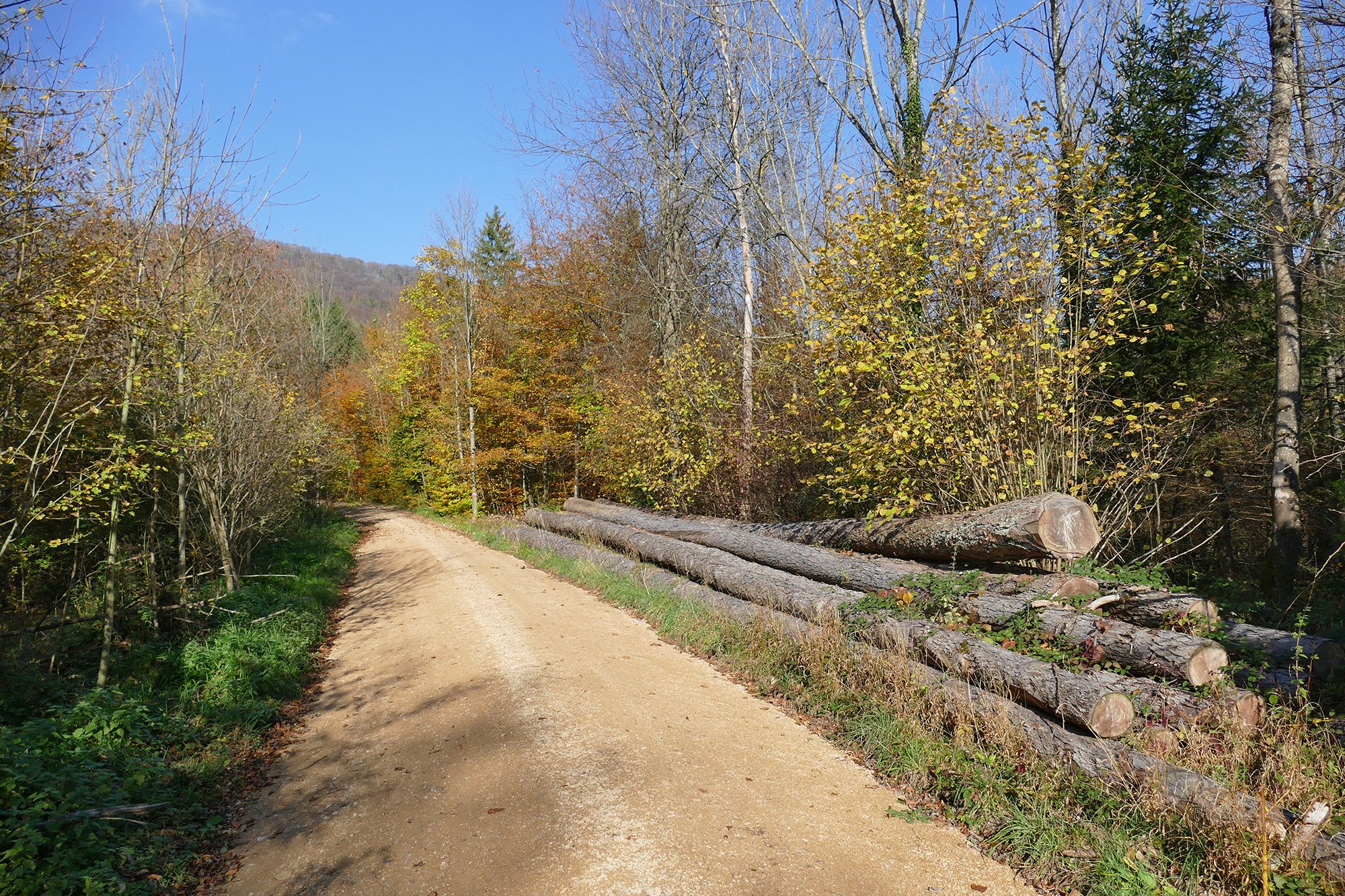
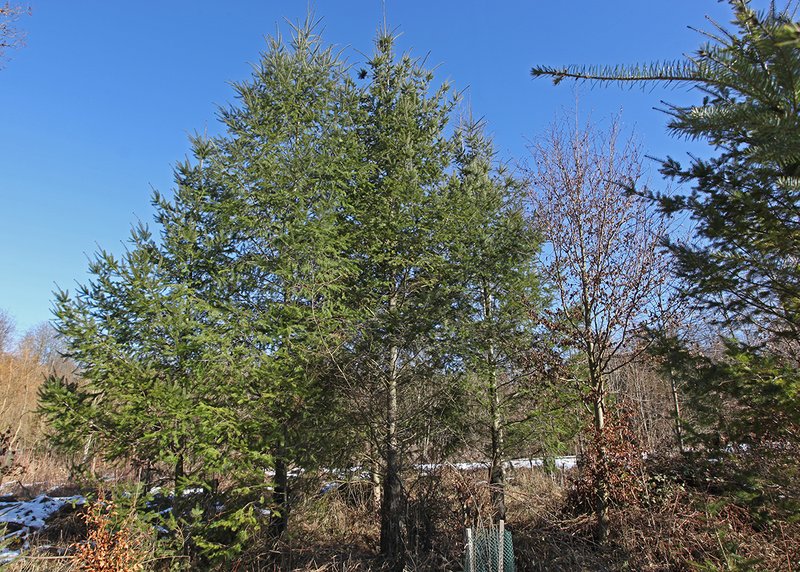
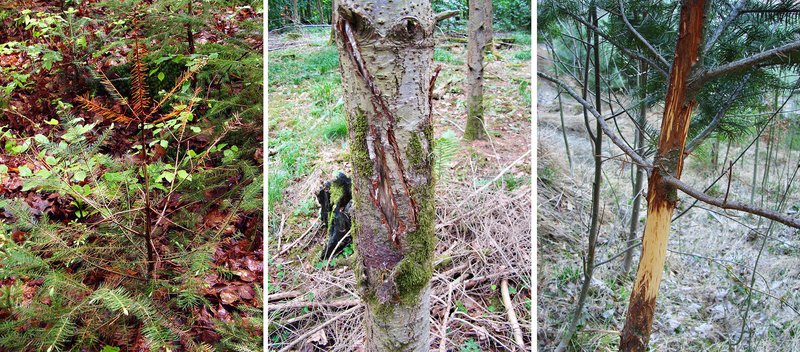

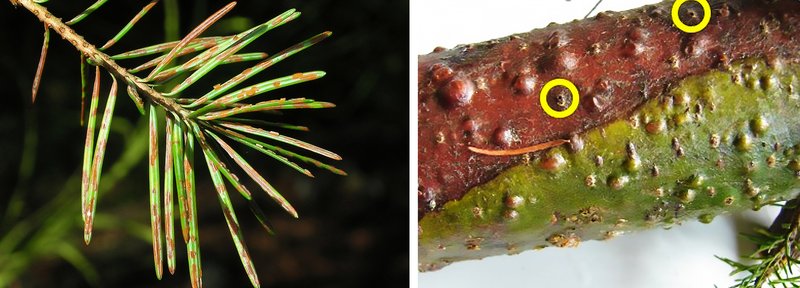
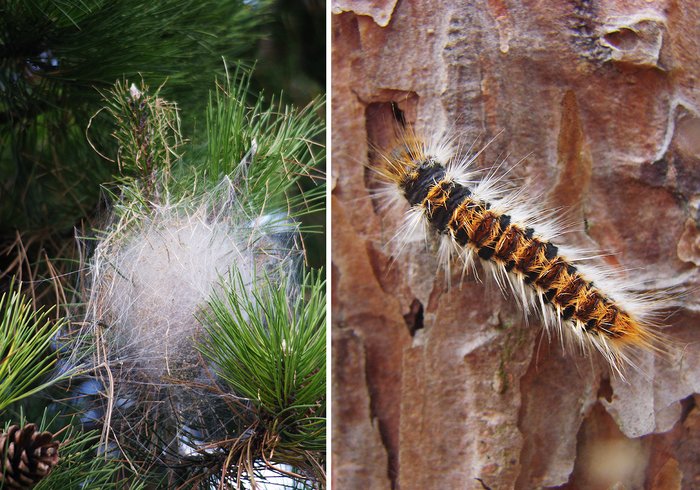
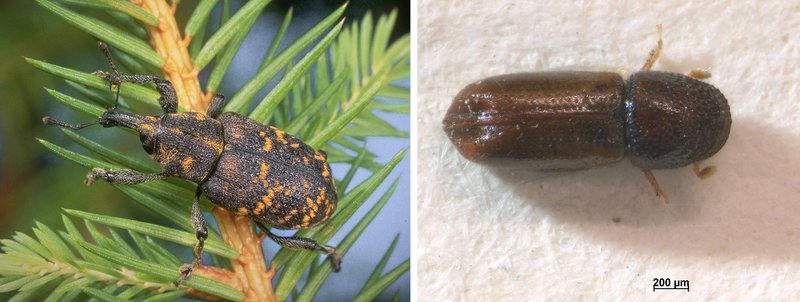
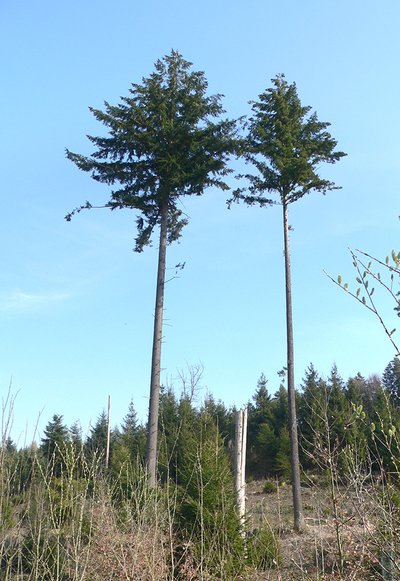
![[Translate to English:] [Translate to English:]](/assets/_processed_/6/c/csm_fva_douglasienholz_2_e31f8d540d.jpeg)
